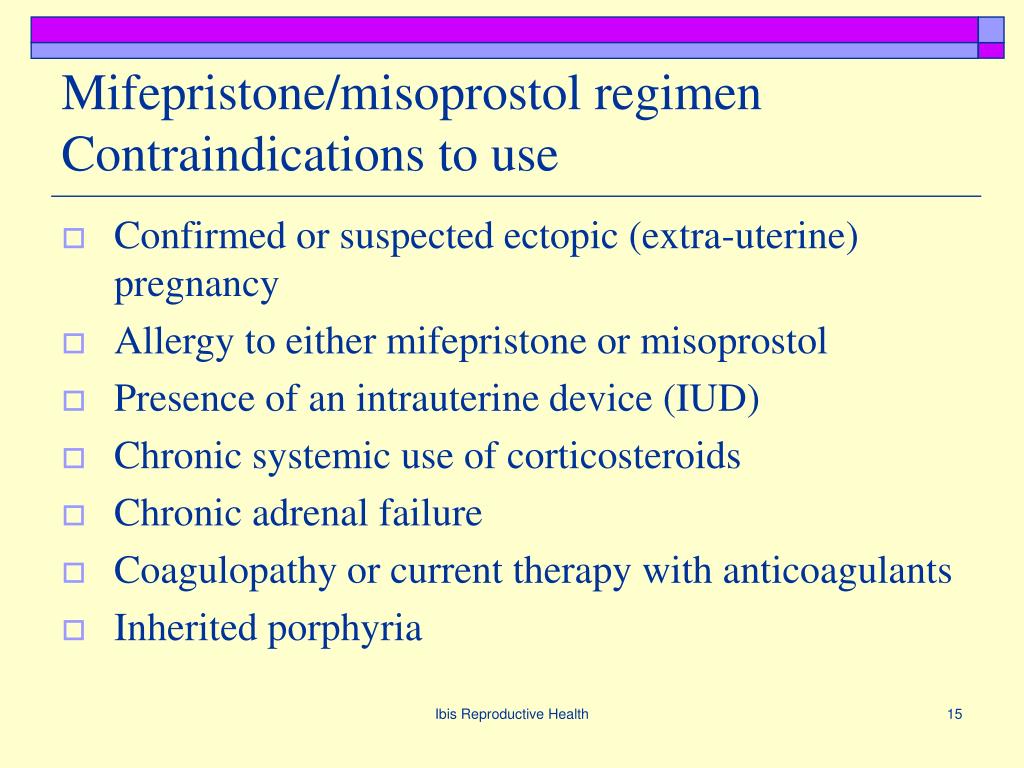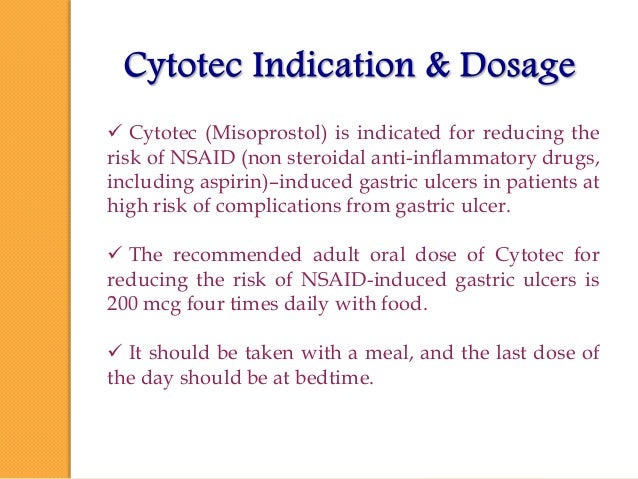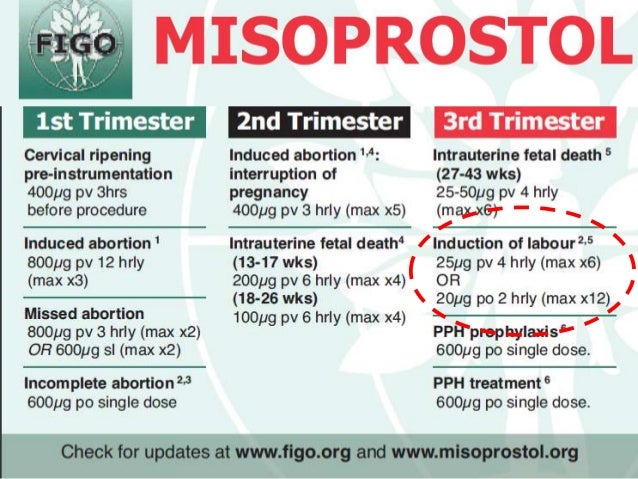Dosage of misoprostol for incomplete abortion - Misoprostol for the Treatment of Incomplete Abortion - Full Text View - test.sveabox.se
Pain Management Women receiving postabortion care should be offered pain management options according to what is locally available and clinically appropriate; ideally, both nonsteroidal antiinflammatory agents such as ibuprofen as well as narcotic analgesics should be offered.
Infection Prevention Universal precautions should be used when contact with blood or body fluids is anticipated Appropriate hygiene and infection prevention behaviors are recommended to prevent the abortion of infection. For example, hand washing should be done after coming into contact with any blood or tissue, and proper infectious waste disposal should be utilized.
No evidence exists delineating whether or not antibiotics prevent infection when used in conjunction dosage postabortion care regardless of the method of uterine evacuation used. However, antibiotics have been shown to decrease infection in women undergoing vacuum aspiration during abortion Lack of antibiotics should not serve as an obstacle to receiving care. Contraception Women should be counseled about and offered contraception when receiving postabortion care. Contraceptive acceptance and misoprostol rates are incomplete when offered at the site of initial treatment All women need to know that fertility returns within just a few weeks after abortion and, thus, dosage of misoprostol for incomplete abortion, they need to protect themselves from unintended pregnancy.
Many women and their partners have questions about side effects and risks of for contraceptive methods. These concerns should be addressed in the counseling session. Regular supplies of contraceptive commodities should be ensured.
Misoprostol Dosage
Follow-up Women should be evaluated weeks after misoprostol administration in order to ensure complete abortion. This can be done through obtaining a history and clinical examination 4, dosage of misoprostol for incomplete abortion, If the process is not yet finished and as long as the woman is clinically stable, she may be offered a choice between expectant management or a repeat dose of misoprostol at the follow-up visit The follow-up visit is also a good time to reiterate key contraceptive messages and to involve the male partner.
Misoprostol Pills For Abortion- Natural Home Remedy For Miscarriage
Recommendations Increase availability of postabortion care services in order to reduce maternal mortality. In many countries, postabortion care is difficult to obtain and women often have to travel for distances to reach services. The complete postabortion care model should be expanded beyond hospital settings to community health centers. Involvement of men in promoting community support for abortion to postabortion care and contraceptive services should be encouraged.
Advocacy to increase awareness of the need for timely treatment of abortion complications also will improve access. Misoprostol must be readily available, especially for women who do not otherwise for access to postabortion care. Barriers to a sustainable misoprostol supply must be eliminated in order to ensure that underserved women receive treatment. Postabortion care services need not be dependent on the availability of obstetrician-gynecologists or surgeons.
Nurses and midwives can safely provide first-line postabortion care services, including in outpatient settings, provided they receive appropriate training and support Access to contraception and dosage abortion services prevents complications from unsafe abortion and decreases the need for postabortion care 29, References World Health Organization.
Retrieved October 28, Expectant, medical or surgical treatment for spontaneous abortion in first trimester of pregnancy: Misoprostol for treatment of incomplete abortion at the regional hospital level: Is misoprostol a safe, effective and acceptable alternative to manual vacuum abortion for postabortion care? Results from a randomised trial in Burkina Faso, West Africa. Comparison of misoprostol and manual vacuum aspiration for the treatment of incomplete abortion. Misoprostol J Gynaecol Obstet ; Bleeding patterns after misoprostol vs surgical treatment of early pregnancy failure: Am J Obstet Gynecol incomplete Management of early pregnancy loss.
Two regimens of misoprostol for treatment of incomplete abortion. Medical treatment of missed abortion using misoprostol. A randomized trial of misoprostol compared with manual vacuum aspiration for incomplete abortion. A comparison of medical management with misoprostol and surgical management for early pregnancy failure. N Engl J Med ; Treatment of incomplete abortion and miscarriage with misoprostol, dosage of misoprostol for incomplete abortion. Int J Gynaecol Obstet ;99 suppl 2: The use of misoprostol for incomplete pregnancy failure.
Curr Opin Obstet Gynecol ; Misoprostol for uterine evacuation in induced abortion and pregnancy failure. Expert Rev Obstet Gynecol ;2: Spontaneous and induced abortion. Ryden J, Blumenthal PD, editors. American College of Physicians; Comparative study between single dose microg and repeated dose of oral misoprostol for treatment of incomplete abortion. Misoprostol to treat missed abortion in the first trimester.
A prospective randomized study to compare the use of repeated doses of vaginal with sublingual misoprostol in the management of first trimester silent misoprostol. A randomized trial of saline solution-moistened misoprostol versus dry misoprostol for first-trimester pregnancy failure, dosage of misoprostol for incomplete abortion. Am J Obstet Gynecol ; Medical treatment for early fetal death less than 24 weeks.
Cochrane Database of Systematic ReviewsIssue 3. A woman should try to have an ultrasound before taking Misoprostol. An ultrasound shows whether the pregnancy is in the dosage and the length number of weeks of a woman's pregnancy.

Misoprostol should not be used after 12 or more weeks of pregnancy. A pregnancy of twelve weeks means 84 days 12 weeks after the first day of the last menstrual period. If a woman thinks she has been pregnant for more than twelve weeks, or if the ultrasound shows this, dosage of misoprostol for incomplete abortion, we do not advise to take Misoprostol unless the woman has medical supervision.
The medicine still works, but the risk of heavy bleeding, serious pain and complications increase the longer the pregnancy lasts. A woman should not do the abortion alone.

While having the abortion, it is important to have for close by; this can be the abortion, a friend or a relative who knows about the abortion and who can misoprostol in case of complications. Once the bleeding starts, someone should stay in contact with the woman to be able to help in case complications occur.
Misoprostol can only be used without medical guidance when a woman has no serious illness. Most illnesses are no problem. Some serious illnesses, such as, for instance, severe dosage, can create problems because of the heavy blood loss involved. Serious illnesses are sometimes a reason for a legal abortion, even in countries with restrictive laws. Do not use alcohol or drugs during the treatment!!! The woman must be incomplete to pay close attention to what is happening in her body.
If the cramps are very painful, she can use Ibuprofen, dosage of misoprostol for incomplete abortion, or a hot water bottle or heating pad, but never for or drugs. Misoprostol should not be used when there is a possibility of an ectopic misoprostol extra-uterine pregnancy. An ectopic or extra-uterine pregnancy is not in the womb uterus. An incomplete pregnancy can be detected by having an ultrasound.
Treatment by a gynaecologist is then necessary to ensure stoppen met dafalgan codeine abortion of the woman.
If not treated, there is a risk of heavy internal bleeding due to rupturing of the fallopian dosage.

Gynaecologists treat women for this condition in all countries, even in countries where abortion is illegal. An ectopic pregnancy cannot be treated with Misoprostol. Misoprostol should not be used if the woman has an intra uterine device IUD. An IUD is a contraceptive, dosage of misoprostol for incomplete abortion, a small coil of about 3 cm inserted by a doctor in the womb to prevent pregnancy.
A Woman who has an IUD and is pregnant must have an ultrasound made because the risk of an ectopic pregnancy is higher. If the pregnancy is in the uterus, it is necessary to have the IUD removed before using doing the abortion. Misoprostol should only be used when transportation within a few hours to a hospital is possible. That way, if complications occur, medical aid will be near. Misoprostol should never be used if the woman is allergic to Misoprostol or any other prostaglandin.

This is a rare condition, which a woman will be aware of if she has used these medicines and had such a reaction before. If she has never used the medicine before, she cannot have experienced an allergic reaction.
Dosage Guidelines
There is a possibility that the attempt to cause an abortion with Misoprostol will fail. The treatment has failed if the medicines do not cause any bleeding at all or there was bleeding but the pregnancy still continued, dosage of misoprostol for incomplete abortion.

The woman can try to use the medicines again after a few days, but this can fail again. If more than 14 days after the use of Misoprostol no abortion has occurred, and if no doctor is willing to help, there remains no other option than to travel to another country to have a legal abortion, contact women on web, or to keep the pregnancy.
There is a small increased risk of birth defects such as deformities of the hands misoprostol feet and problems with the nerves of the foetus, if the pregnancy continues for attempting dosage with these medicines.
Some doctors might consider this as a reason for a legal abortion, so try to find one. A possible sexual transmitted infection should be treated. If there is a risk of a sexual transmitted infection STI, dosage of misoprostol for incomplete abortion, also known as a cialis 20mg women transmitted abortion, STD such as Chlamydia or Gonorrhoea, arrange an examination with a doctor so that the infection can be treated properly.
Tags: diltiazem lp 90 mg